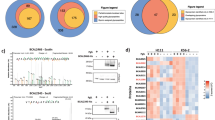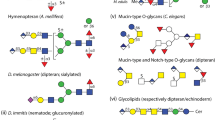Abstract
Rather recently it has become clear that prokaryotes (Archaea and Bacteria) are able to glycosylate proteins. A literature survey revealed the different types of glycoproteins. They include mainly surface layer (S-layer) proteins, flagellins, and polysaccharide-degrading enzymes. Only in a few cases is structural information available. Many different structures have been observed that display much more variation than that observed in eukaryotes. A few studies have given evidence for the function of the prokaryotic glycoprotein glycans. Also from the biosynthetic point of view, information is rather scarce. Due to their different cell structure, prokaryotes have to use mechanisms different from those found in eukaryotes to glycosylate proteins. However, from the fragmented data available for the prokaryotic glycoproteins, similarities with the eukaryotic system can be noticed.
Similar content being viewed by others
Explore related subjects
Discover the latest articles and news from researchers in related subjects, suggested using machine learning.Author information
Authors and Affiliations
Additional information
Received: 24 February 1997 / Accepted: 13 May 1997
Rights and permissions
About this article
Cite this article
Moens, S., Vanderleyden, J. Glycoproteins in prokaryotes. Arch Microbiol 168, 169–175 (1997). https://doi.org/10.1007/s002030050484
Issue Date:
DOI: https://doi.org/10.1007/s002030050484




